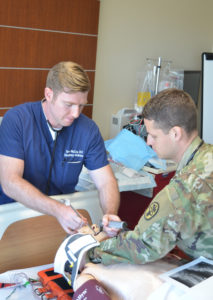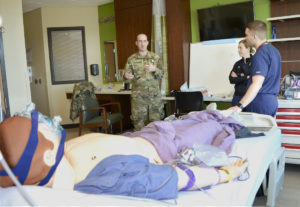by Patricia Deal
FORT HOOD, Texas—Practice makes perfect and the Carl R. Darnall Army Medical Center Simulation Lab helps doctors and nurses perfect their skills through realistic training.
Realistic simulated environments allow healthcare professionals to learn and practice the specific skills, communication, teamwork and critical thinking they need to improve their efficiency and competency to ensure patient safety.
“The biggest benefit of our training is that we’re able to replicate real-life situations. We have 10 different mannequins that can perform many of the same functions as patients. We just received a Sim Man 3G which is the most up-to-date, high fidelity mannequin available,” said Charles Steiner, CRDAMC Simulation Center administrator. “We provide actual monitors and other medical equipment that the doctors would use in the hospital and set-up our training rooms exactly like actual patient rooms to further enhance the fidelity of the training.”
The simulation lab primarily supports CRDAMC’s Graduate Medical Education Family and Emergency Medicine Residency training programs. The residents train in the lab weekly and monthly, in concert with their training program progress. As part of their training, residents are given different scenarios typical of what they may face in real life. An instructor is with them to assess their actions and provide feedback.
“When presented with a particular case, the residents are expected to put what they’ve learned into practice. They have to take action, make decisions, and utilize resources available to them in order to care for their patient,” said Capt. Malia Moore, the emergency medicine and hospital simulation director. “The high-fidelity mannequins that we use have heart beats, they breathe and even have pupils that react to light. We can control the mannequin’s functions and attached monitoring equipment to present with specific symptoms and to even replicate situations where patients may have a reaction to a prescribed treatment or their condition worsens.”
As part of their sim lab training, emergency medicine residents typically don’t know what scenario they will have to handle.
“In emergency medicine you don’t always know what’s coming through the door. ER physicians have to be prepared to act immediately on critically injured patients,” said Joel Miller, EM physician and GME instructor. “So we want to expose our residents to a variety of those type of situations where they have to make quick-thinking decisions and know how to order whatever they’re going to need for the care of that particular patient. “
A big benefit of sim training, Miller said, is that it allows the instructors to control the learning environment. They can also simulate cases that ER physicians may not encounter in that severity or as frequently, but they would still be expected to manage.
“With sim training, we have the luxury to kind of slow things down and discuss particular management points and actions. It allows have a much more meaningful kind of teaching experience,” Miller said. “As an instructor, it’s exciting for me train them and then work with them in the ER and see them bringing the lessons that they learned here to the bedside.”
Capt. Hugh Hiller, EM resident said he believes that the simulation training is a great adjunct to the resident education program.
“I think the best way to become proficient at something is to learn by doing. SIM training allows us to practice real-life situations in a controlled environment, plus gives us the benefit of being able to review best practices and garner advice from our instructors. It gives us hands on experience that we can apply to our day-to-day practice and help us become more confident and competent,” Hiller said.
In addition the GME residency programs, the sim lab also provides training for other departments.
“Everyone at the sim lab does a fantastic job accommodating the training needs of the different departments throughout the hospital. Whenever I come up with an idea of something that I would like for the residents to go through, the sim lab staff almost always has a work around or solution to make that happen,” Moore said. “There may be other simulation centers around that have more than we have, but we do wonders with what we have. We’re proud of our accomplishments, especially in that we are the only sim lab in DoD to receive a five-year accreditation by the Society for Simulation in Healthcare in Teaching and Education.”


